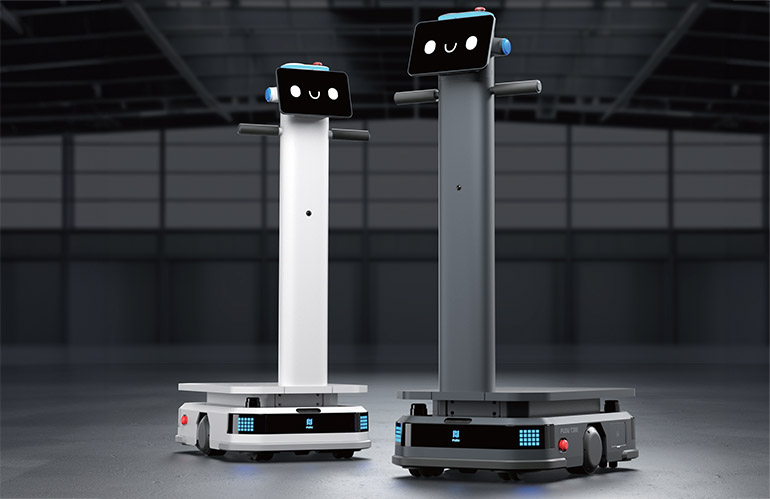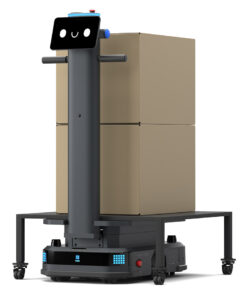|
Listen to this article |

The PUDU T300 mobile robot dis designed for use in tight aisles with heavy payloads. Source: Pudu Robotics
Pudu Technology Co. said today at Hannover Messe that it is expanding from service robots into supply chain applications with the new PUDU T300 mobile robot. The Shenzhen, China-based company said its new robot offers maneuverability, a “map-and-go” feature, and flexible deployment to help manufacturers worldwide.
“There is a huge demand from industrial clients for automated, flexible robotics solutions that can operate continuously to meet high production rates and improve operational efficiency,” stated Felix Zhang, founder and CEO of Pudu Robotics.
“As manufacturers struggle to attract and retain talent, the T300 fills the immediate gap by seamlessly integrating with facilities’ current processes, as well as optimizing operations to spur sector-wide innovation,” he said.
 Learn from Agility Robotics, Amazon, Disney, Teradyne and many more.
Learn from Agility Robotics, Amazon, Disney, Teradyne and many more.
Pudu said that it holds nearly 1,000 patents worldwide and that it has shipped more than 70,000 units to retail, dining, hospitality, healthcare, entertainment, and education customers. The company also specified the following capabilities:
- VSLAM+ navigation: The new mobile robot can adapt to environments with ceilings up to 30 m (98.4 ft.).
- Internet of Things (loT): PUDU T300 includes secure door access, elevator control, a self-configuring network with call options, and production-line material requests via an app for integration into production processes.
- Multimodal interaction: High-brightness operation-indicator lights and traffic-signal lights display PUDU T300’s position and cruising intentions, with customizable buttons for collaboration and audible alerts for reminders.
- Efficient charging: Pudu said the T300 features automatic recharging in about two hours and quick battery-swapping capabilities, allowing for continuous 24/7 operation to cater to different customer requirements.
- Safety compliance: PUDU T300 adheres to ISO 3691-4 industrial safety requirements and includes lidar, depth camera, collision-protection edges, and emergency stop buttons.
Zhang replied to the following questions from The Robot Report:
Pudu Robotics sets its sights on manufacturers
Since there are already numerous mobile robot providers serving manufacturing and warehousing, why did Pudu decide now to get into that space?
Zhang: Pudu Robotics decided to venture into the industrial mobile robot market due to the recognition of a significant demand for lightweight material transportation within industrial settings.
These environments often present complex challenges such as narrow pathways, mixed-traffic scenarios with both humans and machines, and areas with suspended obstacles that require robots to operate safely and flexibly. Unfortunately, there is a gap in the market, as existing products do not adequately fulfill the needs of these specific applications.
Our experience in the foodservice industry, where similar demands for safety, flexibility, and advanced navigation exist, has allowed us to accumulate a wealth of technical expertise, such as SLAM technology and a robust supply chain system. We believe that these skills and resources are directly transferable and highly beneficial to the industrial domain.
Moreover, the industrial robotics market presents several favorable conditions for Pudu Robotics:
- The market potential is vast.
- The frequency of item delivery in the industrial sector is much higher, with a stronger need for such services. A single robot can perform over 200 delivery tasks per day compared with the food service industry, where a robot performing over 70 tasks a day is already considered significant.
- The acceptance of robot deliveries in the industrial sector is higher due to the commonality of automated transportation and manufacturing processes.
- Our market research and practice have shown that by selling standardized products, we can successfully cater to industrial customers.
What was the biggest difference in developing mobile robots for manufacturing in comparison with the service robots that Pudu is known for?

PUDU T300 moving a box in standard mode. Source; Pudu Robotics
Zhang: The biggest difference in developing robots for manufacturing in comparison to service robots lies within the distinct market needs and opportunities of the industrial sector. Manufacturing allows for more standardization, higher frequency of use, and stronger customer demand than the service industry.
Yet the value-added is similar. Both manufacturing and service industries turn to automation to alleviate labor shortages, bolster workplace safety and productivity, and adapt to an evolving market. Pudu can easily leverage its expertise in one to innovate within the other.
What’s the biggest differentiator between the T300 and other companies’ robots?
Zhang: PUDU T300 features automatic recharging and quick battery-swapping capabilities. This allows for continuous 24/7 operation and allows customers to expedite production.
With its ability to navigate through spaces as narrow as 60 cm [23.6 in.], the T300 can shuttle between production lines, delivering supplies without hindrance.
T300 also supports several key functions like PUDU VSLAM+, a fusion of laser SLAM and visual SLAM for positioning, which PUDU has extensive experience in, this lets the robot adapt to its environment and update its map in real time.

PUDU T300 can tow a cart. Source: Pudu Robotics
PUDU T300 will work with PUDUlink platform
What’s the new robot‘s payload capacity? What sorts of goods is the T300 designed to move — machine parts, pallets, or something else?
Zhang: The PUDU T300 has a payload capacity of 300 kg [661.3 lb.] and is specifically designed to serve in the material logistics of discrete manufacturing, handling tasks like delivering supplies to production lines, transferring materials between different production areas, and assisting in the delivery of samples for quality inspection.
The PUDU T300 is capable of transporting raw materials, cardboard boxes, material bins, material racks, and more.

PUDU T300 in lifting mode. Source: Pudu Robotics
Since the new robots are designed for narrow aisles, are they capable of backing up if they encounter obstacles?
Zhang: The T300 has exceptional maneuverability, remaining agile if it encounters obstacles. The robot is able to cross 0.7 in. [1.7 cm] thresholds and 1.3 in. [3.3 cm] gutters, as well as to leverage laser and visual SLAM for positioning in spaces up to 200,000 sq. m [2.1 million sq. ft.].
In addition to these capabilities, the T300 is also designed with a reverse function, enabling it to back up and disengage from any impediments it may encounter.
In addition to the VSLAM capabilities, how will Pudu’s latest robots be monitored — will the company offer fleet management software, or will it work with third-party platforms?
Zhang: The PUDU T300 will be monitored using our proprietary distributed scheduling system, which allows for efficient management and coordination of the robot fleet.
Additionally, the T300 supports PUDUlink, a platform developed by Pudu Robotics for remote device management. This platform enables operators to monitor, control, and update the robots from a centralized location, ensuring smooth operation and quick response to any issues that may arise.
Furthermore, for those clients who wish to integrate the T300 with their existing third-party fleet management or scheduling systems, the T300 is designed to be compatible with third-party APIs [application programming interfaces]. This ensures that our robots can be seamlessly incorporated into a wide range of industrial and logistical environments, providing flexibility to users who already have established systems in place.
What customers did Pudu work with in developing this robot, and is it in trials or is it already available?
Zhang: T300 was developed specifically for customers within the industrial sector. Target customers include entities within manufacturing, such as 3C [computer, communication, and consumer] electronics manufactures, automotive parts processing facilities, metalworking and hardware processing enterprises, and more.

PUDU T300 in shelf mode. Source: Pudu Robotics





